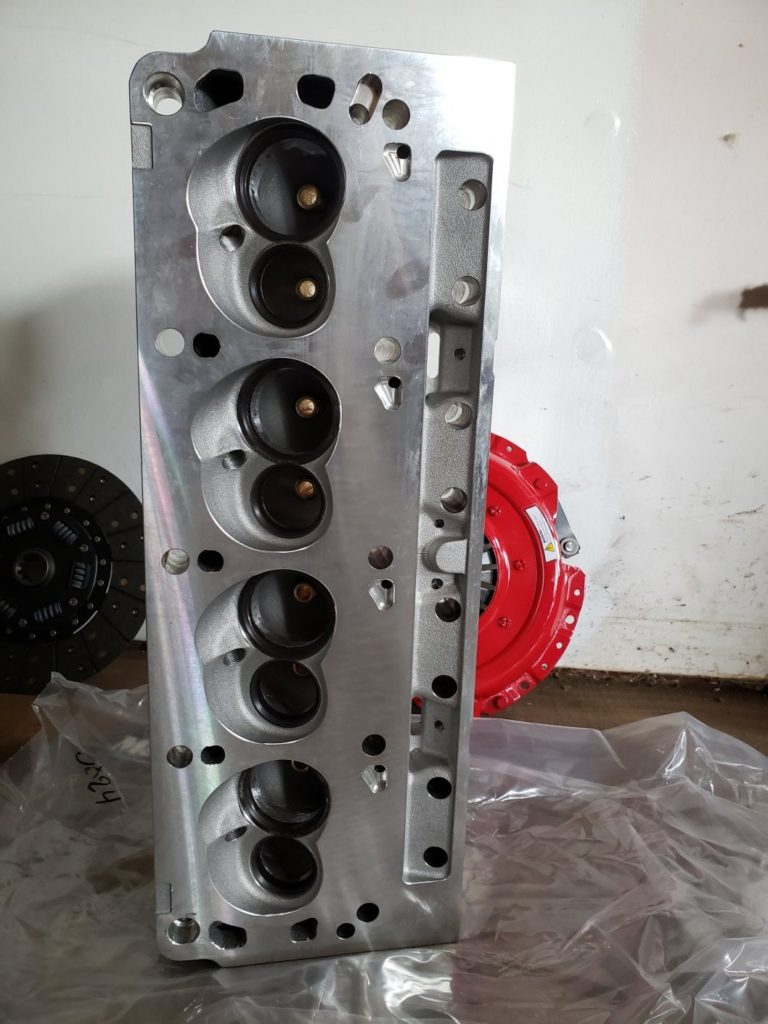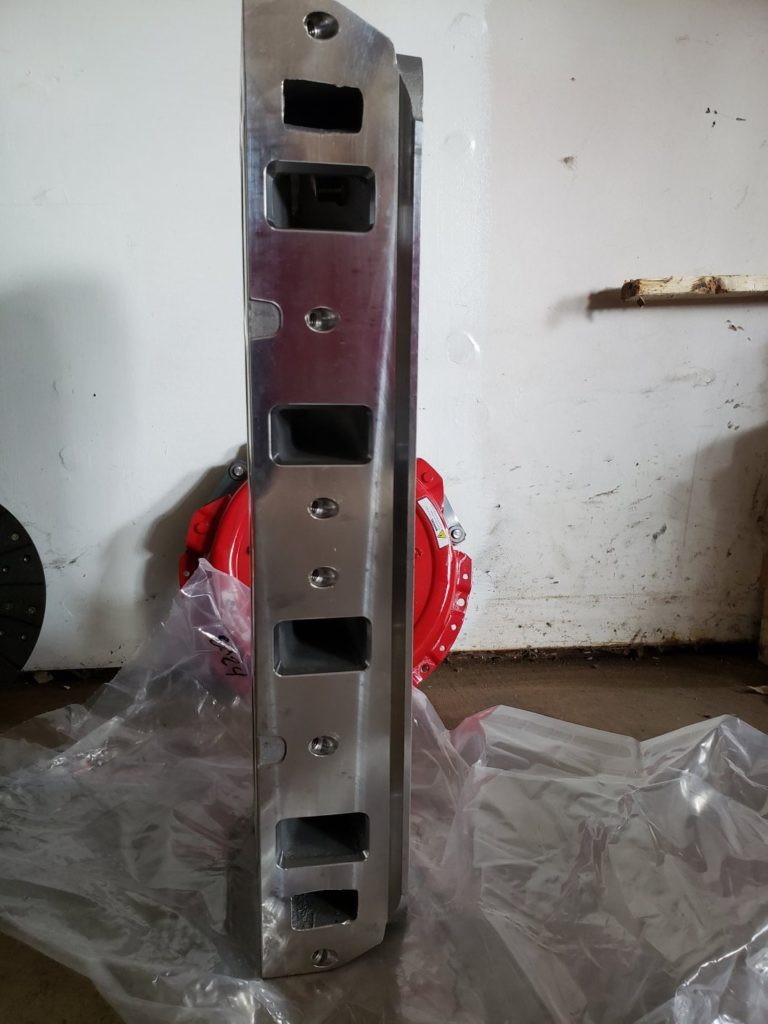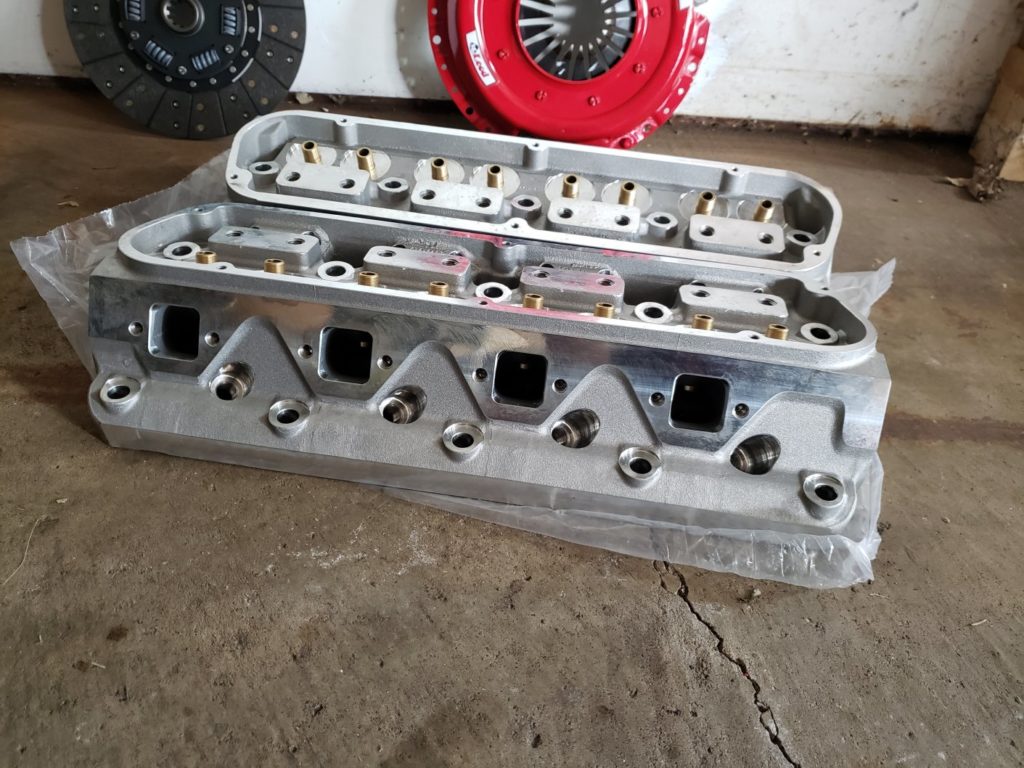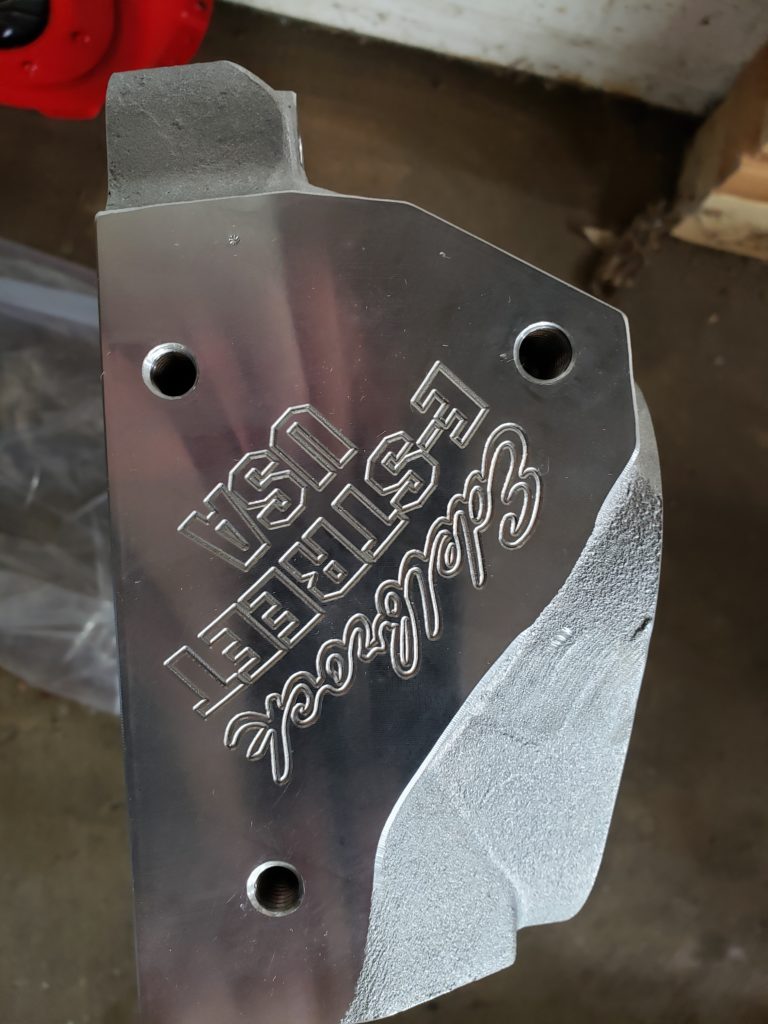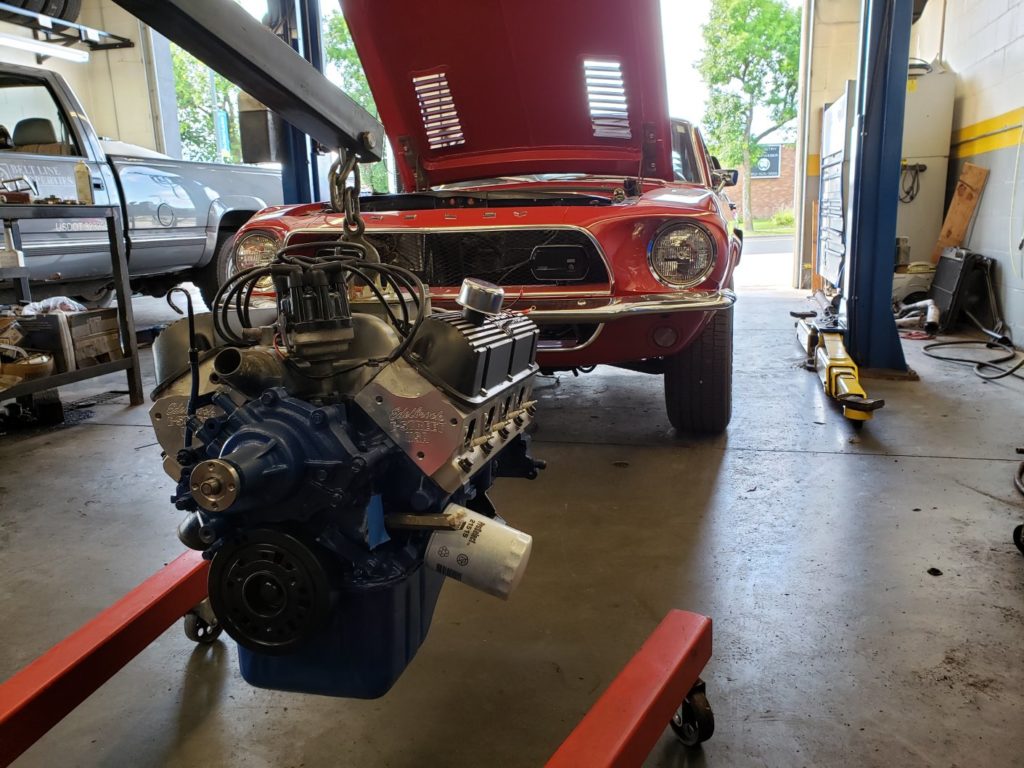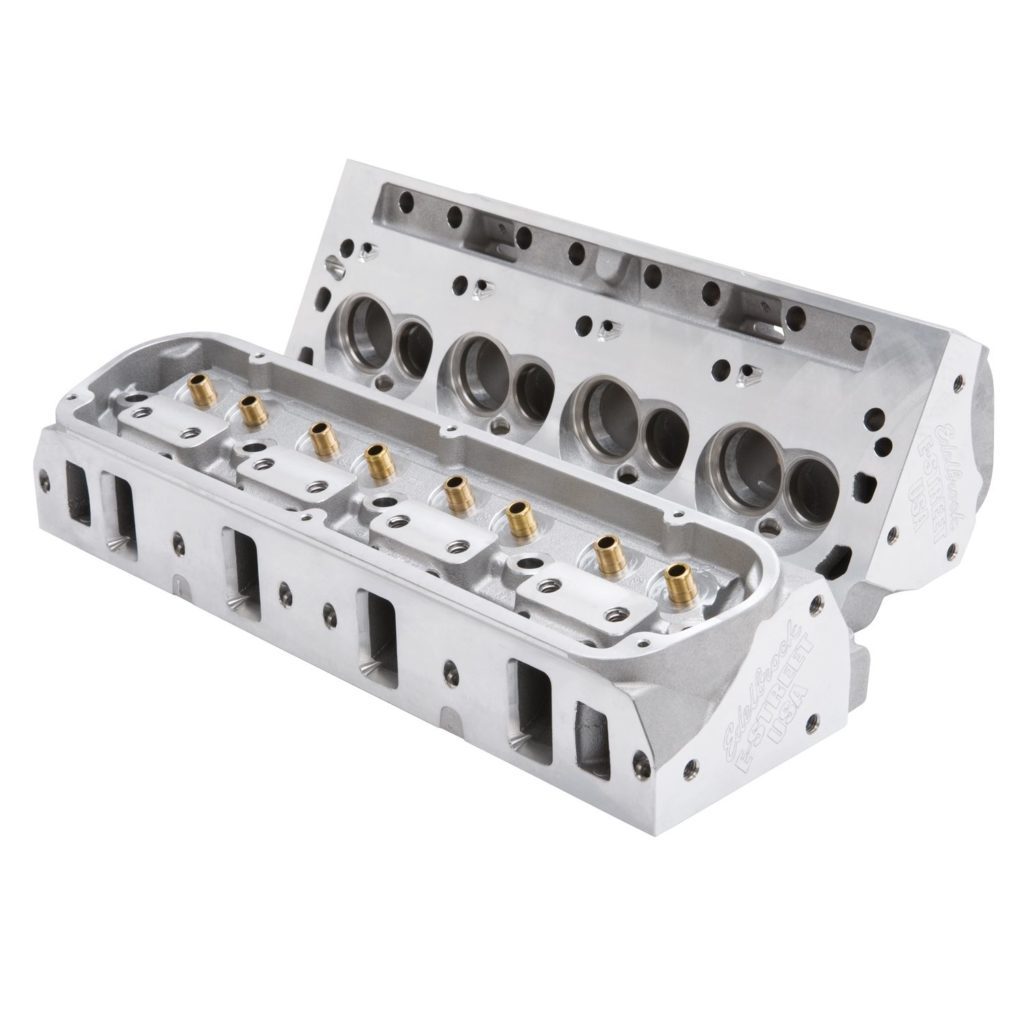
Aluminum Heads on my old Block
Return to the prior page My GT 350
The stock cylinder heads on my engine had to come off to fix the bad head gaskets. If you’re taking the heads off it’s a good idea to inspect the engine. The last time those heads were off that engine was in 1983. The second part of this question is to recognize the heads on an engine, especially the heads on this small block Ford, are a limitation in the synergy of this engine. Air and fuel need to come in and exhaust needs to go out through the heads.
The stock Ford heads were pretty basic and designed to help this engine offer 220-250 HP. The combustion chamber is 63.0, intake valve/Exhaust valve diameter was 1.78/1.45″. Interesting the 1967 HiPo 289 specs had a combustion chamber of 54.5 and intake/exhaust diameter is 1.78/1.45″. Smaller combustion chamber giving higher compression, but the valves are the same size. The other issue with the stock heads is the they should be ported to make the air flow more smoothly.
In selecting heads for a small block Ford, you need to consider how the car is going to be used. This is a street driven car and not a race car. The stock heads are too small so any increase in valve and port size would help. These Edelbrock valves are not as large as the Boss 302 heads (2.23″ intake, 2.19″ exhaust). But the Boss Mustangs were designed to be a high revving engine.. Those larger valves work best at higher RPMs. I am not going to be doing many high RPM runs with my car. The Edelbrock head’s valve size is a good compromise. Large enough to bump the fuel and air in and exhaust out, but not too big. The other thing about heads is the runners and ports should be smooth to not interrupt the air flow. The stock heads are cast iron with little concern about air flow.
Dan, the engine builder, and I discussed what to do about the heads on this build. He wanted to port and clean them up. I already knew the cost of a set of bare Edelbrock heads, New heads were about $350 more than Dan wanted to clean up those stock heads. The Edelbrock heads already had bigger valves and better air flow. The other selling point is aluminum bleeds off heat much better than cast iron heads. This would help any detonation issues I might have. And two of these heads weigh less than one cast iron head. Plus they would look very cool on this engine. Potentially these heads alone could add 35 HP.
With the Edelbrock heads, the intake valve would go from 1.78″ to 2.02″, a 35% increase. The exhaust valves were 1.45″ going to 1.60″, an 11% increase. Plus the ports and air flow should be tremendously improved. And the Comp Cam chosen will also leave the valves open longer letting even more fuel and air into the cylinders. More fuel and air creates more horsepower. And in an engine build, every gain in HP counts. I wanted to add 100 HP? Here is 35 of that number.
These heads also have screw in studs for the rocker arms. The key difference between the stock Ford 289 4 barrel engine and the infamous Ford 298 HiPo and Boss 302 engines were threaded studs. This allows the engine to hit higher RPM’ and not come apart. The stock heads had pressed in studs.
The E-Street heads fit my engine nicely. I was concerned that my intake and exhaust headers would not fit these new heads. The only issue Dan, the builder, ran into was he had to do a valve job on the new heads to get the valves to seat. That was a disappointment on new $1000 heads.
Hot Rod article about testing six set of heads for Ford 302 to see why I chose these heads for my engine build.
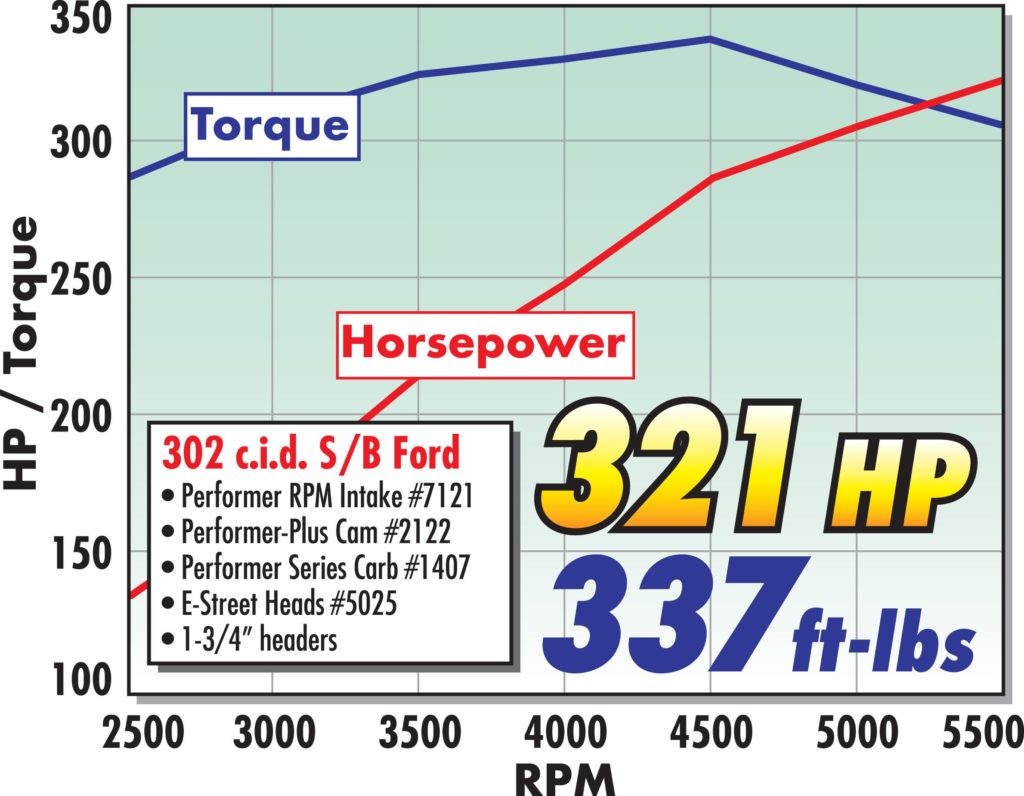
============================
Specs and info from Edelbrock
Edelbrock # 5024 Aluminum Heads for larger valves and better breathing.
Head Casting Number 6025P
Combustion Chamber Volume 60.0 cc
Intake Runner Volume 170.0 cc
Intake and Exhaust ports 2.02″
https://www.edelbrock.com/small-block-ford-e-street-bare-cylinder-heads-2-02-5024.html
The Edelbrock #5024 E-Street cylinder heads are designed for Ford 289-351 W V8 applications. The Edelbrock E-Street cylinder heads offer American made quality and affordable performance. E-Street cylinder heads feature as-cast ports and are designed for entry-level street performance applications operating in the idle-to-5500 rpm range. The modern combustion chamber designs improve the combustion process and larger than stock intake and exhaust ports move more air through your engine for improve efficiency. For use on pre-pollution controlled vehicles only.
- Head Casting Number 6025P
- Rocker arm studs & guide plates are not included with bare versions of E-Street cylinder heads.
- Ideal for operating in the idle to 5500 rpm range
- Use with hydraulic flat tappet camshafts, .550″ maximum lift – not compatible with hydraulic roller camshafts
- 289-302 with 7/16″ head bolts require #9680 head bolt kit
- 2.02″ heads require additional piston to valve clearance
- Recommended spark plugs are Champion RC12YC or equivalent 14mm x 3/4″ reach with flat gasket seat.
- Requires hardened pushrods. 289-302 c.i.d. with 7/16″ head bolts requires #9680 head bolt bushing kit.

| Edelbrock E-Street | Stock 1968 4 bbl heads | Stock 66 2 bbl heads | 1993 GT-40P heads | 1969-70 Boss 302 | |
| CNC Ported | No | No | No | No | |
|---|---|---|---|---|---|
| Combustion Chamber Volume | 60.0 cc | 53.5 cc | 54 -58 cc | 60-63 cc | |
| Deck Height | 9.5 in | ||||
| Deck Thickness | 0.625 in | ||||
| Guide Plates Included | No | ||||
| Intake Runner Volume | 170.0 cc | 135 cc | 155 cc | ||
| Material | Aluminum | iron | iron | iron | iron |
| Push Rod Diameter | 0.312 in | ||||
| Valve Angle | 20 deg | ||||
| Intake/Exhaust valves size | 2.02″/1.60″ | 1.78/1.45″ | 1.78/1.45″ | 1.85″/1.46″ | 2.23″/1.78″ 2.19″/1.72″ |
| Intake/Exhaust Ports | 1.94 x 1.04″ / 1.24 X 1.0″ |
